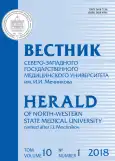The peculiarities of brain bioelectrical activity in infants who suffered from stress due to military conflict depending on type of feeding
- Authors: Shirina T.V.1, Ershova I.B.1
-
Affiliations:
- Lugansk State Medical University named after St. Luke
- Issue: Vol 10, No 1 (2018)
- Pages: 55-60
- Section: Reviews
- URL: https://journals.rcsi.science/vszgmu/article/view/8813
- DOI: https://doi.org/10.17816/mechnikov201810155-60
- ID: 8813
Cite item
Full Text
Abstract
The aim of the research is to study the peculiarities of brain electrical activity in infants who suffered from stress due to military conflict and who were on different types of feeding.
An electroencephalographic study was conducted in 68 infants who were in the military conflict zone and formed the main group. These infants were divided into 2 subgroups. Subgroup Ia included 36 infants who were breastfeeding. Subgroup Ib included 32 infants who were on artificial feeding. EEG was also made to 88 children who made up a control group and were outside the zone of military conflict. Of these, 47 children were breastfed, who entered the subgroup IIa and 41 children were on artificial feeding, included in subgroup IIb.
The study was carried out with the help of a hardware-software complex for recording and processing electroencephalograms and evoked potentials DX-NT 32.
The most pronounced physiological changes in brain bioelectrical activity were detected in the group of children undergoing stress of war and being on artificial feeding, which were manifested by lower parameters of the amplitude, frequency and time index of alpha and beta rhythms, increased amplitude, frequency and time index of delta and theta rhythms.
Full Text
##article.viewOnOriginalSite##About the authors
T. V. Shirina
Lugansk State Medical University named after St. Luke
Author for correspondence.
Email: shirina_olga@mail.ru
Ukraine, Lugansk
I. B. Ershova
Lugansk State Medical University named after St. Luke
Email: shirina_olga@mail.ru
Russian Federation, Lugansk
References
- Благосклонова Н.К., Новикова Л.А. Детская клиническая электроэнцефалография. – М., 2000. – 202 с. [Blagosklonova NK, Novikova LA. Detskaja klinicheskaja jelektrojencefalografija. Moscow; 2000. 202 p. (In Russ.)]
- Кравцов Ю.И., Жарныльская Е.Л. Электроэнцефалографические показатели и речевое развитие в динамике до 3-летнего возраста у детей // Казанский медицинский журнал. – 2011. – Т. 92, № 6. – С. 17–21. [Kravtsov’ YuI, Zharnylskaya’ EL. Electroencephalographic indicators and speech development in the dynamics up to the 3rd year of age in children with mild to moderate perinatal brain damage. Kazanskij medicinskij zhurnal. 2011;92(6):17-21. (In Russ.)]
- Строганова Т.А., Дегтярева М.Г., Володин Н.Н. Электроэнцефалография в неонатологии. – М.: ГОЭТАР-Медиа, 2005. – 280 с. [Stroganova TA, Degtjareva MG, Volodin NN. Jelektrojencefalografija v neonatologii. Moscow: GOJeTAR-Media; 2005. 280 p. (In Russ.)]
- Алферова В.В., Фарбер Д.А. Отражение возрастных особенностей функциональной организации мозга в электроэнцефалограмме покоя // Нейропсихология детского возраста. – М., 2012. – С. 45–65. [Alferova VV, Farber DA. Otrazhenie vozrastnyh osobennostej funkcional’noj organizacii mozga v jelektrojencefalogramme pokoja. Nejropsihologija detskogo vozrasta. Moscow; 2012. P. 45-65. (In Russ.)]
- Фарбер Д.А., Бетелева Т.Г., Горева А.С., и др. Функциональная организация развивающегося мозга и формирование когнитивной деятельности // Физиология развития ребенка. – М., 2000. – С. 82–104. [Farber DA, Beteleva TG, Goreva AS, et al. Funkcional’naja organizacija razvivajushhegosja mozga i formirovanie kognitivnoj dejatel’nosti. Fiziologija razvitija rebenka. Moscow; 2000. P. 82-104. (In Russ.)]
- Горбачевская Н.Л. Особенности формирования ЭЭГ у детей в норме и при разных типах общих (первазивных) расстройств развития: дис. … д-ра биол. наук. – М., 2000. – С. 53–67. [Gorbachevskaja NL. Osobennosti formirovanija JeJeG u detej v norme i pri raznyh tipah obshhih (pervazivnyh) rasstrojstv razvitija. [dissertation] Moscow; 2000. P. 53-67. (In Russ.)]
- Жирмунская Е.А., Сорокопут Г.Д. Использование электроэнцефалографии в поликлинической практике: метод. рекомендации. – М., 2006. – 117 c. [Zhirmunskaja EA, Sorokoput GD. Ispol’zovanie jelektrojencefalografii v poliklinicheskoj praktike: metod. rekomendacii. Moscow; 2006. 117 p. (In Russ.)]
Supplementary files







